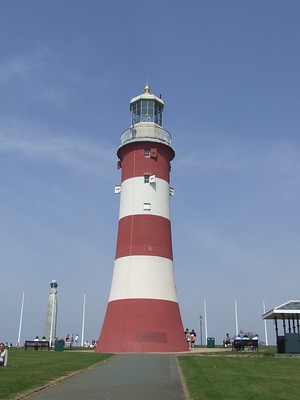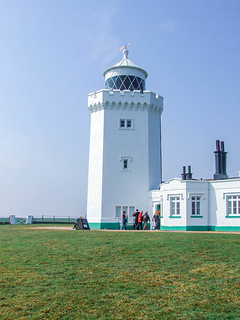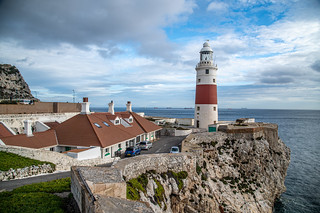The Eddystone Lighthouse is a lighthouse that is located on the dangerous Eddystone Rocks, 9 statute miles (14 km) south of Rame Head in Cornwall, England. The rocks are submerged below the surface of the sea and are composed of Precambrian gneiss.
This tower was the third lighthouse to be built on the Eddystone and marked a major step forward in the design of such structures.
In 1877 it was resolved to build a fourth replacement lighthouse, following reports that erosion to the rocks under Smeaton's tower was causing it to shake from side to side whenever large waves hit. During construction of the new lighthouse, the Town Council of Plymouth petitioned for Smeaton's tower to be dismantled and rebuilt on Plymouth Hoe, in lieu of a Trinity House daymark which stood there. Trinity House consented to the removal and delivery of the lantern and the upper four rooms of the tower, the cost of labour to be borne by Plymouth Council.[34] While the new tower was being built the old lighthouse remained operational, up until 3 February 1882 (after which a temporary fixed light was shown from the top of the new tower).
The upper part of Smeaton's lighthouse was subsequently rebuilt, as planned, on top of a replica granite frustum on Plymouth Hoe: preserved 'as a monument to Smeaton's genius, and in commemoration of one of the most successful, useful and instructive works ever accomplished in civil engineering'.[34] The rebuilding was funded by public subscription. It remains in place today and, as 'Smeaton's Tower', is open to the public as a tourist attraction.
en.wikipedia.orgMy own great grandfather was a keeper at Smeeton's Tower when it was out at Eddystone.
Lighthouses
Smeeton's Tower, Plymouth
Farol do Cabo de São Vicente
The Lighthouse of Cabo de São Vicente (Portuguese: Farol do Cabo de São Vicente) is beacon/lighthouse located along the coastal peninsula of Sagres Point in the civil parish of Sagres, in the Portuguese municipality of the Vila do Bispo. Not to be confused with the Lighthouse of Ponta de Sagres, which is the located further to the edge of the extreme southwest cape of the civil parish, southwest of the Fortress of Sagres.
A rudimentary lighthouse existed on the cape since 1520, in a special tower constructed on the site of the convent.[2] Between 1521 and 1557 a tower was ordered constructed by King D. John III to defend the coast from attacks from marauding soldiers. Yet, in 1587, the tower was destroyed by the English privateer Francis Drake, and only returned to operation in 1606, following its restoration by order of King Phillip II.
The lighthouse of Cape St. Vincente, or the Lighthouse of D. Fernando, was ordered constructed by Queen D. Maria II, and began operating in October 1846, in the 16th century Franciscan convent.[2] It was originally illuminated by olive oil lamp consisting of two clarions that rotated every two seconds, and a range of 6 nautical miles (11 km; 6.9 mi).
en.wikipedia.org
South Foreland, Kent
South Foreland Upper Lighthouse was built in 1843. It went out of service in 1988 and is currently owned by the National Trust. It was the first lighthouse to use an electric light, and was the site chosen by Guglielmo Marconi for his pioneering experiments in wireless radio transmissions.
The lighthouse was connected to mains electricity in 1922, whereupon South Foreland Lighthouse became the first to use an incandescent lightbulb as its light source. At around the same time the 16-sided optic was adapted to give the lighthouse a new group-flashing characteristic (three flashes every twenty seconds). The Holmes generators, which had provided power for fifty years, were then disconnected, and the Holmes arc lamp was given to the Science Museum. The subsequent reduction of required maintenance, and provision of automatic electric equipment (including an electric winder for the clockwork mechanism to turn the lens), led to a reduction in staff numbers from one engineer and four keepers to just a single keeper. In the event of a bulb failure, an automatic lamp changer was activated (and an alarm notified the keeper); if the reserve bulb then failed, the lamp changer caused an acetylene burner to be brought into position and lit.
The lighthouse has been in the ownership of the National Trust since 1989. As such it is open to the public.
en.wikipedia.org
Cap Fréhel
Classified as an historic monument, the lighthouse of the cape Fréhel takes place in the Côtes-d'Armor, in Brittany, in the town of Plévenon. Bathed by the bay of Saint-Brieuc, it extends over more than thirty meters in height.
The first lighthouse was built at the beginning of the 18th century on the original instructions of Vauban. The latter was completely redesigned in the first half of the 19th century, before being destroyed by the Second World War. The current lighthouse was built between 1946 and 1950, entirely in freestone.
Considered one of the five most powerful lighthouses in France, the Cap Fréhel lighthouse covers more than fifty-three kilometers.
www.france-voyage.com
Chania Lighthouse, Crete
hania Lighthouse, is a lighthouse located at the entrance of the port of Chania, on the island of Crete, Greece. It was built in 1864 on the site of the original lighthouse by the Venetians. It has been a listed archeological site in Greece since 1962
Chania Lighthouse was originally a naval post created by the Venetians that would protect the city from oncoming Turks or pirates. In 1645, the Turks took control of the city, during which the lighthouse was left to ruins. Egyptian troops, who were aiding the Ottoman Empire in protecting Crete, rebuilt the lighthouse in 1864: only the base of the original lighthouse remains. In May 1915 a fixed white light was installed, marking it is an official lighthouse in Greece's network. The lighthouse suffered damage in World War II, and was refurbished in 2006.
en.wikipedia.org
Lighthouse at Barra
The Lighthouse of Praia da Barra, also known as the Aveiro Lighthouse , is an active lighthouse in the civil parish of Gafanha da Nazaré, municipality of Ílhavo, in the Portuguese district of Aveiro. Situated on the coastal Praia da Barra, at the southern margin of the Ria de Aveiro, it is the tallest lighthouse in Portugal, with a height of 203 feet (62 m) overseeing the barrier beach and exposed to Atlantic storms.
The lighthouse tower including the beacon apparatus dome, stands 66 metres (217 ft) high and the light beam has a range of 23 nautical miles (43 km).[3] The round stone tapering tower rises from a two-storey rectangular building housing the lighthouse keeper living quarters and is painted externally in red/white broad hoops, while an internal spiral staircase of 271 stone steps (followed by an additional 20 metal steps) reaches the top and the elevator moves through the middle of the spiral stairway.
en.wikipedia.org
The Needles Lighthouse, Isle Of Wight
The Needles Lighthouse is an active 19th century lighthouse on the outermost of the chalk rocks at The Needles on the Isle of Wight in the United Kingdom, near sea level. Designed by James Walker, for Trinity House at a cost of £20,000. It was completed in 1859 from granite blocks, stands 33.25 metres (109.1 ft) high and is a circular tower with straight sides. It replaced an earlier light tower on top of a cliff overhanging Scratchell's Bay, which was first lit on 29 September 1786.
Today the main lamp is a 1500W bulb; the fixed optic with its coloured sectors remains in use as of 2019.[20] Due to the condition of the chalk strata on which the lighthouse was built, in April 2010 a £500,000 underpinning project was announced, designed to stop the lighthouse falling into the sea. Over a 12-week period from early June, civil marine contractors Nuttall John Martin excavated a trench around the base of the lighthouse, to install a ring of stabilising posts, reinforced with concrete
en.wikipedia.org
Europa Point, Gibraltar
The Europa Point Lighthouse, also referred to as the Trinity Lighthouse at Europa Point and the Victoria Tower or La Farola in Llanito, is a lighthouse at Europa Point, on the southeastern tip of the British Overseas Territory of Gibraltar, on the southern end of the Iberian Peninsula, at the entrance to the Mediterranean Sea.
Europa Lighthouse was inaugurated on 1 August 1841 in a brief ceremony witnessed by about 10,000 people. The first upgrade of the lighthouse occurred in 1864, when the single-wick lamp was replaced with a Chance Brothers four-wick burner, with further changes in 1875 and in 1894 when the amount of light emitted was increased. A three incandescent mantle burner was added in 1905. Following further modernisation in the 20th century, the lighthouse was fully automated in 1994 and converted to LED operation in 2016.
en.wikipedia.org







